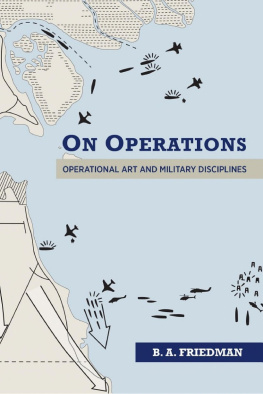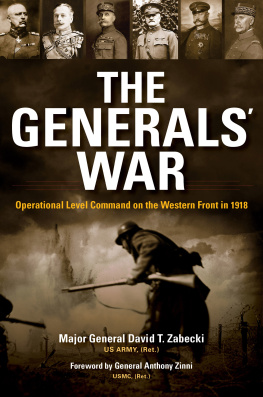BLITZKRIEG TO
DESERT STORM
MODERN WAR STUDIES
Theodore A. Wilson
General Editor
Raymond A. Callahan
J. Garry Clifford
Jacob W. Kipp
Allan R. Millett
Carol Reardon
Dennis Showalter
David R. Stone
Series Editors

BLITZKRIEG TO
DESERT STORM
The Evolution of
Operational Warfare
Robert M. Citino
UNIVERSITY PRESS OF KANSAS
2004 by the University Press of Kansas
All rights reserved
Published by the University Press of Kansas (Lawrence, Kansas 66045), which was organized by the Kansas Board of Regents and is operated and funded by Emporia State University, Fort Hays State University, Kansas State University, Pittsburg State University, the University of Kansas, and Wichita State University
Library of Congress Cataloging-in-Publication Data
Citino, Robert Michael, 1958
Blitzkrieg to Desert Storm : the evolution of operational warfare /
Robert M. Citino.
p. cm.(Modern war studies)
Includes bibliographical references and index.
ISBN 978-0-7006-1300-7 (cloth : alk. paper)
ISBN 978-0-7006-2614-4 (ebook)
1. Operational art (Military science)History20th century. 2. Military history, Modern20th century. I. Title. II. Series.
U163.C54 2004
355.409045dc22 2003020208
British Library Cataloguing-in-Publication Data is available.
Printed in the United States of America
10 9 8 7 6 5 4 3 2 1
The paper used in this publication meets the minimum requirements of the American National Standard for Permanence of Paper for Printed Library Materials Z39.48-1984.
To my daughter Laura
Contents
Illustrations
Introduction
The Day the World Changed
It was 7:00 P.M. on the evening of May 20, 1940, as the first column of German vehicles clattered into the French town of Abbeville at the mouth of the Somme River. They were the spearhead of 2nd Panzer Division, part of General Heinz Guderians XIX Panzer Corps. Considering that Europe was in the midst of a great war, the town was quiet. An occasional Allied plane would appear overhead, but there was no organized French resistance here. A little later that evening, the Spitta Battalion of 2nd Panzer, named for its commander, pressed on from Abbeville and drove the twenty kilometers to Noyelles on the Atlantic coast, occupying it without incident. The men of the unit were tired, but exhilarated. They had reason to be. They had just finished one of the most audacious maneuvers in the history of modern warfare. Having negotiated the difficult, winding trails of the Ardennes forest, they had been part of a massive German armored force that had broken through a weakly defended portion of the French lines at Sedan on May
13. Since then, they had driven at top speed, nearly unmolested, clear across the rear of an immense Anglo-French army in Belgium. In ten short days of action, Spittas men had covered more than two hundred miles, and in fact they had done the last sixty since morning. The battalions arrival at Abbeville and Noyelles spelled doom for the Allied forces to the north. They were now trapped, cut off from their supply base in France, hemmed in on all sides by a combination of the Germans and the sea, and, consequently, not long for this world.
Lieutenant Colonel Spitta undoubtedly knew that he had just taken part in a victorious battle. What he might not have realized was that his drive from the Ardennes to Noyelles heralded a new age in military history. Upper echelons in the German army knew. Consider the testimony of the German Panzer Group commander, General Ewald von Kleist:
I was halfway to the sea when one of my staff brought me an extract from the French radio which said that the commander of their 6thArmy on the Meuse had been sacked, and General Giraud appointed to take charge of the situation. Just as I was reading it, the door opened and a handsome French general was ushered in. He introduced himself with the words, I am General Giraud. He told me how he had set out in an armored car to look for his Army, and had found himself in the midst of my forces far ahead of where he had expected them to be.
Kleist concluded, with some understatement, This was a sidelight on the apparent unexpectedness of our arrival.
Indeed, the German army (Wehrmacht) had just done something that no army in the world had been able to do for decades. The campaign in France, designated by the Germans as Case Yellow (Fall Gelb), was the sort of operation that planners on both sides in World War I had aimed at repeatedly but had failed to carry off. The feint to the north, the disguised main thrust to the south, the encirclement of an entire enemy army in what German staff
The shock was understandable. The world had not seen anything like it for some seventy years. Starting in the late nineteenth century, stalemate had become the predictable outcome when great armies clashed. The Boer War, the Russo-Japanese War, the Balkan Wars, World War I: all featured campaigns that fell far short of the goals that their commanders had set. When victory came, it was typically a victory of attrition, a peace of exhaustion. So expensive were these stalemated wars that defeat often plunged the losing side into political and social revolutionRussia in 1905 and again in 1917, Austria-Hungary and Germany in 1918.
Case Yellow was different, a clever plan executed by a highly mobile, agile military instrument, led by officers who understood the potential of new technology, especially the tank and the airplane. It changed forever the way the worlds armies fought. It changed the way they planned for wars and what they expected to achieve from them. It should be noted, moreover, that the Germans had achieved this revolution, amounting to nothing less than a restoration of the art of war, with a mere ten panzer divisions and ten motorized divisions, a small fraction of the more than one hundred divisions they mobilized for the campaign in the west.
The Work
In the Wake of Blitzkrieg offers a detailed, operational-level look at battlefield developments from 1940, the year of the stunning German victory in France, to 1991 and the successful Coalition assault in Operation Desert Storm. It starts at the point that my previous book, Quest for Decisive Victory: From Stalemate to Blitzkrieg in Europe, 18991940, ended. That earlier work demonstrated how difficult it had become to achieve decisive battlefield victory in the age of the mass army, the rie and machine gun, and rapid-fire artillery. Although the infantry-based armies of the early twentieth century could generate enormous firepower, they were relatively immobile. With their voracious supply needs tying them tightly to the railroad, they were incapable of carrying out the sort of elegant maneuvers that were the stock-in-trade of the great nineteenthcentury captains like Napoleon or Helmuth von Moltke. Because cavalry was increasingly unable to carry out a decent reconnaissance or conduct a pursuit, armies of the day tended to blunder into one another. At this point, a mutual bludgeoning began. Both sides took and inicted huge, often crippling casualties. Even if they managed to achieve a local success, the underdeveloped state of communications technology (based around the telegraph) rendered the command and control of these masses highly problematic. Although opportunities might arise in the course of the campaign, they often went unexploited. This was the particular problem that bedeviled so many military operations in World War I.
During the interwar period, the German army arrived at solutions to most of these problems. Motor technology (tank, truck, and airplaneboth tactical and transport) solved the mobility problem. Radio enabled the commanders to exercise much more effective command and control. It was not, however, a simple case of new inventions and new technology leading to an obvious military revolution. The victory in 1940 was the result of a long period of trial and error, doctrinal experimentation carried out not just in theoretical work but in a detailed and exhaustive series of maneuvers, exercises, and war games.









